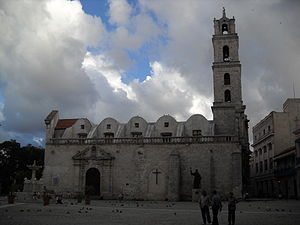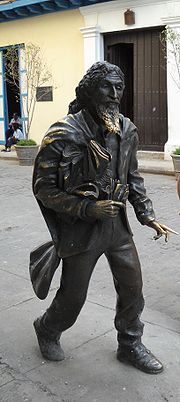
San Francisco de la Habana Basilica
Encyclopedia

Francis of Assisi
Saint Francis of Assisi was an Italian Catholic friar and preacher. He founded the men's Franciscan Order, the women’s Order of St. Clare, and the lay Third Order of Saint Francis. St...
) were built in Havana
Havana
Havana is the capital city, province, major port, and leading commercial centre of Cuba. The city proper has a population of 2.1 million inhabitants, and it spans a total of — making it the largest city in the Caribbean region, and the most populous...
, Cuba
Cuba
The Republic of Cuba is an island nation in the Caribbean. The nation of Cuba consists of the main island of Cuba, the Isla de la Juventud, and several archipelagos. Havana is the largest city in Cuba and the country's capital. Santiago de Cuba is the second largest city...
at the end of sixteenth century (1580-91) as the home of the Franciscan
Franciscan
Most Franciscans are members of Roman Catholic religious orders founded by Saint Francis of Assisi. Besides Roman Catholic communities, there are also Old Catholic, Anglican, Lutheran, ecumenical and Non-denominational Franciscan communities....
community, and were altered in the baroque
Baroque
The Baroque is a period and the style that used exaggerated motion and clear, easily interpreted detail to produce drama, tension, exuberance, and grandeur in sculpture, painting, literature, dance, and music...
style in 1730.
The church was used for their worship by the English during the year in which they ruled Havana. When it returned to Spanish rule, they chose not to use it as a church. It is now used for concerts. Attached to the Basilica is a bell tower (138-ft). Originally a statue of St. Francis of Assisi stood on the top of the bell tower but it was destroyed by a cyclone in 1846. Today a statue of

José Villa Soberón
José Ramón Villa Soberón is a Cuban artist, particularly known for his public sculptures around Havana. He studied at the Escuela Nacional de Arte in Havana, Cuba and the Academy of Plastic Arts in Prague. He is a professor at the Instituto Superior de Arte in Havana...
of José María López Lledín
José María López Lledín
José María López Lledín known as El caballero de Paris was a well known street person in Havana, Cuba in the decade of the 50s.-First years:...
known as El Caballero de Paris
José María López Lledín
José María López Lledín known as El caballero de Paris was a well known street person in Havana, Cuba in the decade of the 50s.-First years:...
(1899-1985) who is buried inside the Basilica.

